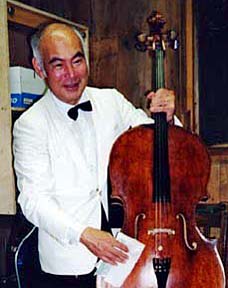
REVIEW
PHOTO COURTESY OF HONOLULU SYMPHONY
Cellist and soloists soar
with a variety of music
Tsutsumi Plays Tchaikovsky
Acclaimed cellist Tsuyoshi Tsutsumi and the Honolulu Symphony perform today at 4 p.m. at the Blaisdell Concert Hall Tickets are $16, $28, $33, $44 and $59.Call 792-2000 for more information.
The fourth program of the Honolulu Symphony's Masterworks Season featured a rich variety of orchestral music and an impeccable performance by guest cello soloist Tsuyoshi Tsutsumi.
The concert opened with the symphonic poem "Don Juan" by Richard Strauss.
Friday's performance featured the sweep and power of the full orchestra as well as the subtlety of individual soloists. Of particular note were Scott Janusch in an expressive oboe solo, concertmaster Ignace Jang in several violin solos, and the French horns, who played their difficult unison passages heroically. The orchestra played with enthusiasm, despite some balance problems in the bombastic sections. Conductor Samuel Wong demonstrated again his skill at bringing the orchestra to a soaring climax in Romantic works.
Tsutsumi, who debuted at age 12 with the Tokyo Philharmonic and is now on the faculty of Indiana University, played two pieces. He introduced himself with passionate intensity in Bruch's popular "Kol Nidrei," ending the short work with an air of serenity. This was followed by Tchaikovsky's "Variations on a Rococo Theme," an ideal showcase for his virtuoso technique.
The work is scored for a very light orchestra, with reduced winds and no trumpets, trombones, or percussion. As a result, the soloist stands out with a clarity seldom encountered in a Romantic concerto. Tsutsumi clearly enjoyed playing the jaunty theme, and he negotiated the difficulties of the variations with ease. His intonation in the very highest registers was impressive, as were his delicate and graceful ornaments. He played the rousing coda with drive and spirit.
The second half of the program was devoted to the ninth symphony of Shostakovich, composed just after the end of World War II. The 1945 audience expected a monumental outpouring of celebration in the tradition of Beethoven's Ninth. The composer instead delivered a work pervaded by the humorous spirit of Haydn, with a generous measure of 20th-century irony.
Shostakovich later recalled: "Stalin was incensed. He was deeply offended, because there was no chorus, no soloists. And no apotheosis. There wasn't even a paltry dedication. It was just my music, which Stalin didn't understand very well." The work has remained an audience favorite, though, and the Honolulu audience seemed to understand it better than Stalin.
The symphony features the woodwinds extensively, both as soloists and as a section. Principal clarinetist Scott Anderson was equally adept in the plaintive second movement and the brilliant third movement. The fourth movement was virtually a concerto for principal bassoonist Paul Barrett, who received an enthusiastic ovation from his fellow musicians during the final bows.
E. Douglas Bomberger is a professor of music at the University of Hawaii at Manoa.
